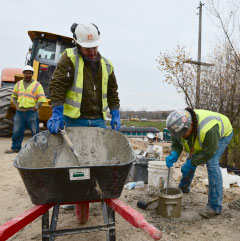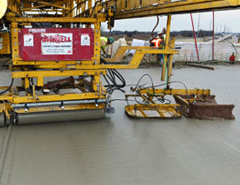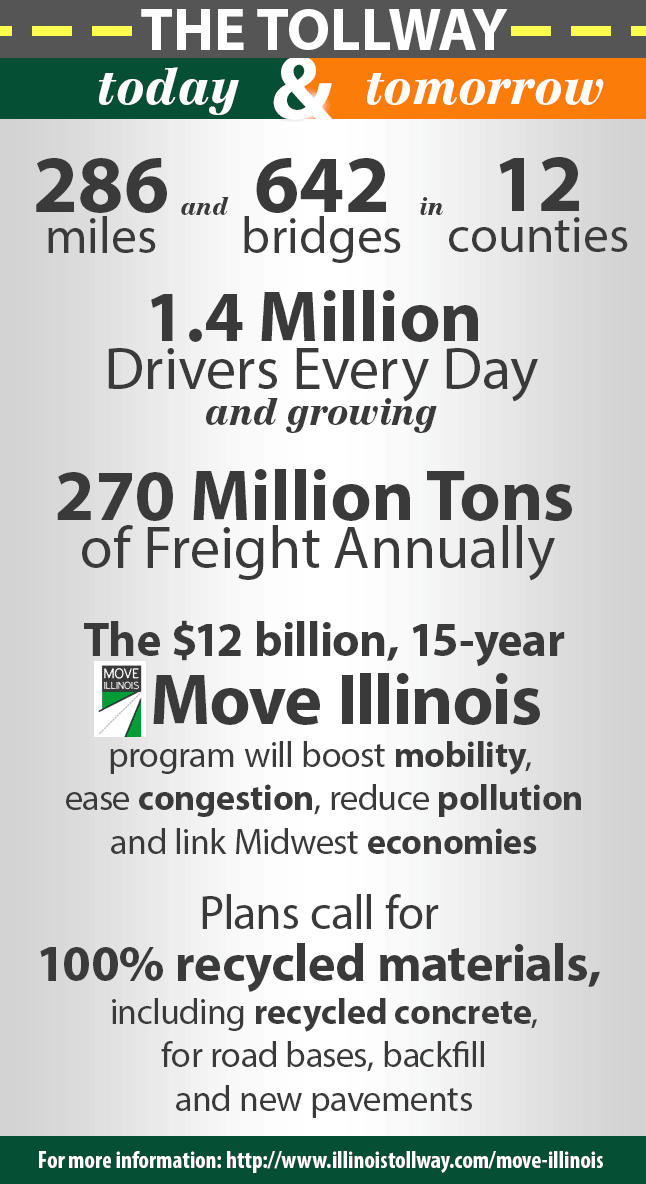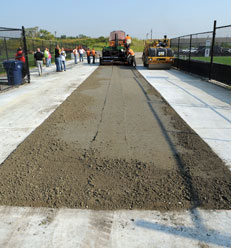Of all the riding surfaces owned and maintained by the Illinois Tollway, bridges are by far the most vulnerable to decay.
“These unsupported spans are up in the air, facing extreme stresses every day,” explains Tollway Deputy Program Manager for Materials Steve Gillen. “Heavy salting in cold weather drives damage, too. Chloride finds its way through even the tiniest cracks, corroding steel reinforcement and accelerating bridge failure.”
Ultimately, that’s bad news for the 1.4 million drivers who ride the Tollway system daily – and suffer frustrating delays whenever spans must be rebuilt.
Pushing for a solution

More than a decade ago, Tollway engineers sought to develop a new high-performance concrete (HPC) mix for exclusive use in maintaining the system’s 642 bridge decks.
“Our first mixes focused on minimizing permeability to chloride,” says Gillen, “but we experienced even more cracking. So we shifted our thinking, choosing stainless steel reinforcement to minimize corrosion, and aimed for maximum crack control.”
The Tollway partnered with CTLGroup in Skokie, Illinois, to develop performance-based specifications and produce trial batches of the first anti-crack mixes. As work continued, they formed a technical review panel of contractors and suppliers (including Prairie experts) and representatives of the Illinois Department of Transportation.
Proprietary mix cures from the inside out
Working with CTL’s specs, Prairie’s mix development team explored a range of solutions. The resulting P2P mix will deliver 75 to 100 years of service, up to 3 times the current lifespan of bridges in the Tollway system.
Prairie’s proprietary formula uses saturated lightweight fines to help the concrete cure from the inside out, explains Prairie Regional Sales Manager Rich Shadle.
“The fines are a coarse, manufactured sand that’s light and highly absorbent,” Shadle notes. “They are pre-wetted and added to the mix. Following placement they release moisture, acting as an internal curing agent to control natural shrinkage as the deck hardens.”
Figuring out precisely the right amount of fines to add to the ternary blend – composed of cement, fly ash, slag and other cementitious materials – was crucial, Shadle says. “We sought the ideal mixture proportioning to balance the water supplied by the pre-wetted fines with that demanded by the hydrating cement paste in the mixture.”
Joint-free spans will resist decay
Crews from Dunnet Bay Construction of Glendale Heights, Illinois rebuilt 3 Tollway bridges this season using the new mix. All spans are part the Jane Addams Memorial Tollway (I-90) between Elgin and Rockford.
The new decks were designed without joints to minimize deterioration at those stress points. “Using the concept of integral abutment bridges, we placed jointless spans of up to 550 feet,” says Gillen. Most Tollway bridge lengths are only several hundred feet, he notes.
Prior to the pours, experts at CTL worked with Prairie’s Yard 14 to test and certify the new mix. Yards 14 and 19 provided more than 1,000 yards for the subsequent projects, including the Powers Road crossroad bridge, a 350-foot span just west of the Elgin toll plaza (shown in photos).
“Air entrainment was also crucial to ensure durability ,” says Prairie’s Technical Services Director and QC expert Steve Fleming. “Each load at Powers Road was tested for compliance with the 5% to 8% requirement, and we tested several loads after placement since, due to site restrictions, workers used a collapsible conveyor system instead of pumping the concrete.”
Innovation for a stronger infrastructure

Prairie is proud to serve as the Tollway’s partner in developing better mixes for bridge and road construction, Fleming says. “We appreciate the Tollway’s leadership in pushing for innovative solutions that can be used by other road and bridge builders to improve our infrastructure.”
With the largest QC staff in its service area, Prairie is well-positioned to meet the needs of Tollway contractors going forward, he adds. “We also have the greatest number of plants and trucks near the various sites,” he says, “so we look forward to more projects as the Tollway’s 12-year renewal project moves forward.”






 United Materials
United Materials Superior Materials
Superior Materials Prairie Materials
Prairie Materials Canada Building Materials
Canada Building Materials VC Global
VC Global